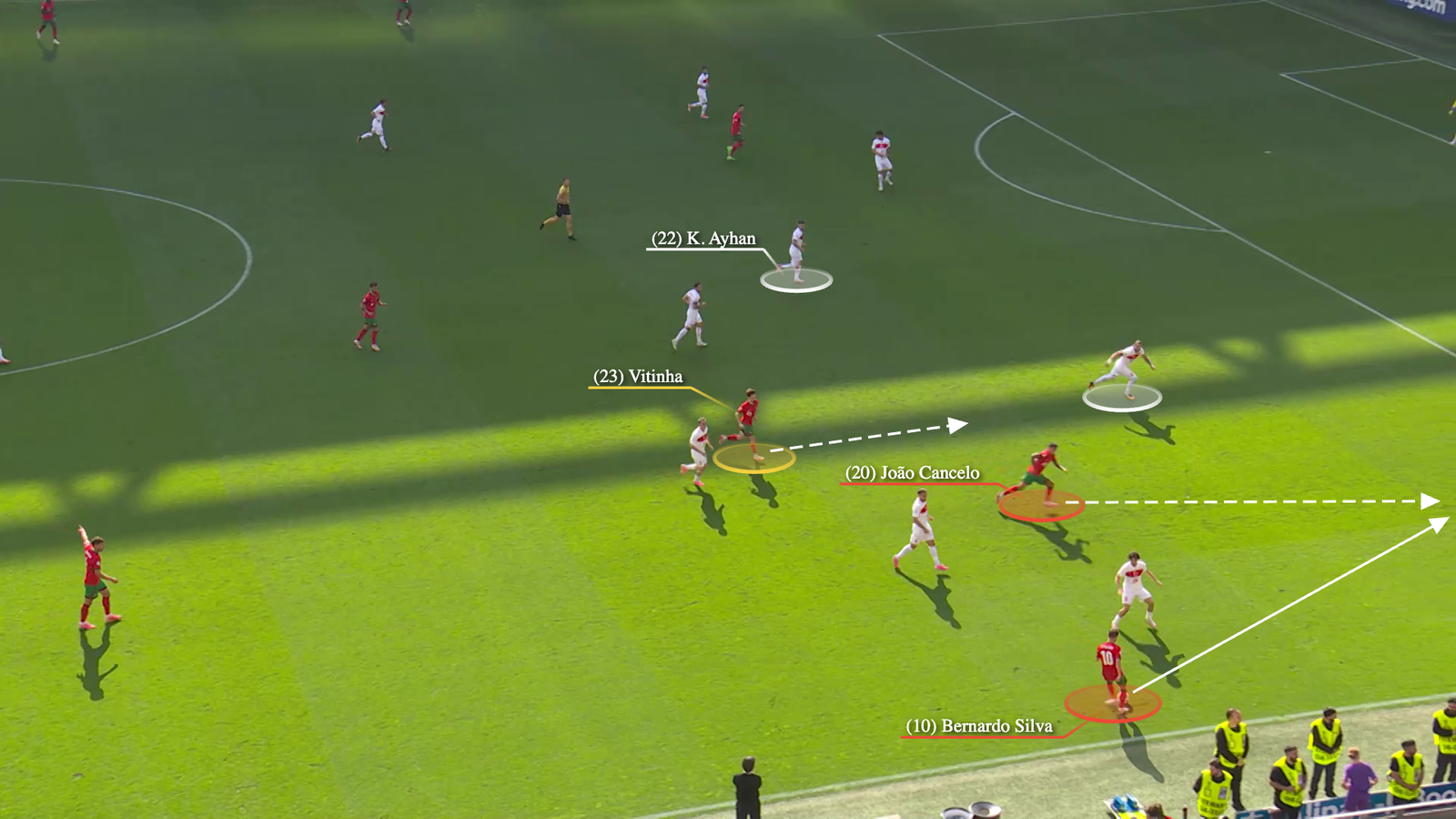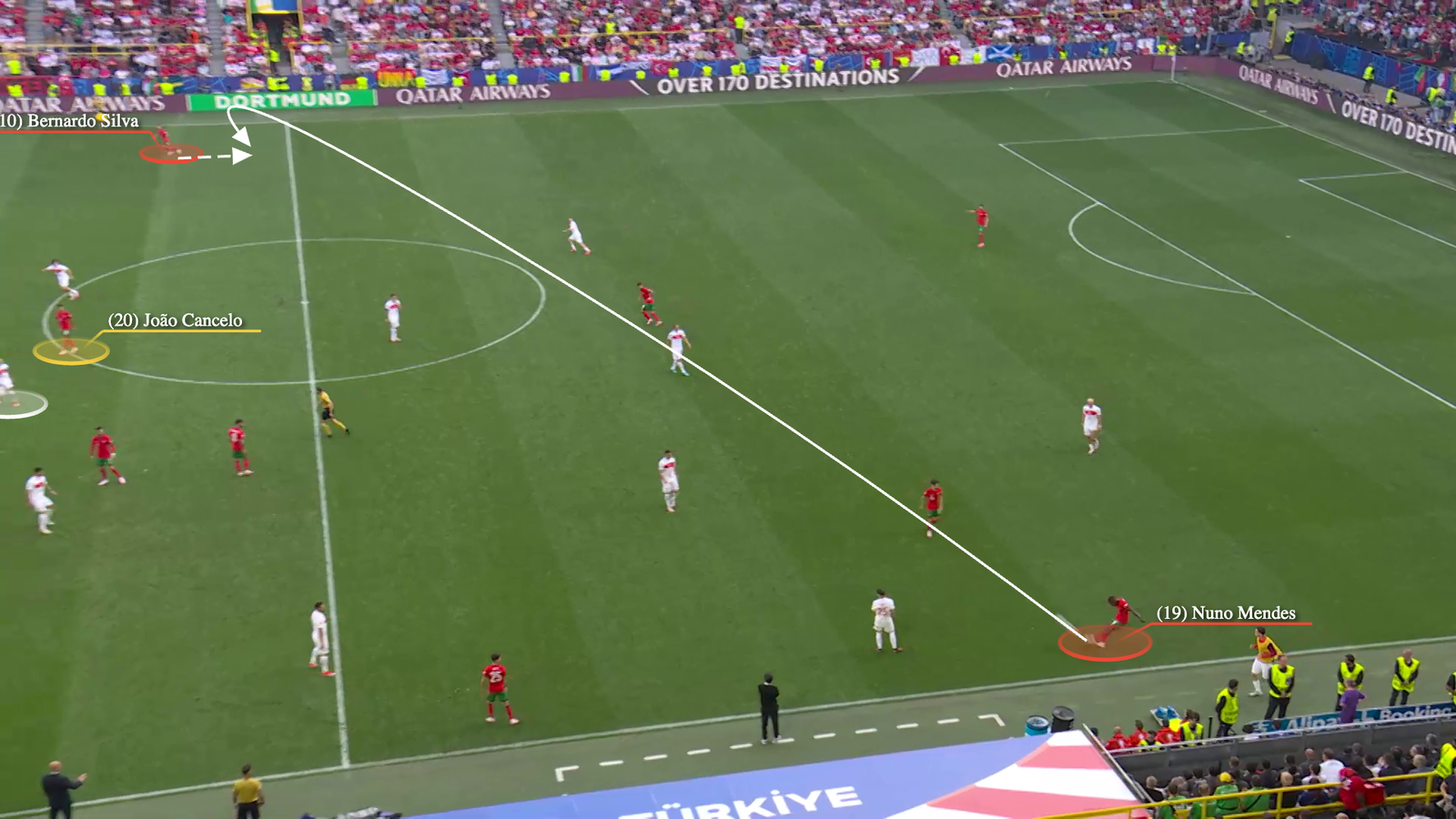Before Portugal’s second match in this European Championship against Turkey, a popular question was whether Roberto Martinez would stick with the back three he played in the 2-1 victory against Czech Republic or move to a four-man defence.
Portugal alternated between the two shapes in their qualifying campaign — but formations on paper do not tell the whole story. On their journey to Euro 2024, Martinez’s back four often moved to a back three in possession with Joao Palhinha dropping between the centre-backs, as in the shot below.
Formations can change depending on the phase of play — a team defending in a back four can move to a back three on the ball or vice versa — but what is also important is the dynamics of how they defend or attack during that phase, and the profiles of the players in the assigned roles.
Against Turkey, Portugal moved to a back four and the interesting positioning in possession was not that of Palhinha but Joao Cancelo who roamed inside the pitch from right-back.
Bernardo Silva mainly occupied the right wing…

… but during Portugal’s first attack of the match, he moved in-field…

… and attacked the space as Nuno Mendes was playing the ball to Rafael Leao down the left wing. The positioning of Bernardo posed a question for Turkey’s left-back, Ferdi Kadioglu, who knew that Cancelo (out of shot) was down the right wing, but the crucial factor here was Bernardo’s off-ball movement while Portugal were progressing the ball.

Football is dynamic, and formations on paper are static. The skill sets of the players, their roles and their movements matter, whether it is in a deep build-up, high press or an attack in the final third.
In the example below, Bernardo attacks the space behind Turkey’s right side with an off-ball run that allows Bruno Fernandes to find him, with Kadioglu unable to react because of his initial positioning and the threats of Cancelo and Cristiano Ronaldo (out of shot).


Bernardo then tries to find Ronaldo towards the back post, but the latter shoots straight at goalkeeper Altay Bayindir.


In another example, Vitinha combines with Cancelo to reach Bernardo down the right wing. Meanwhile, Kaan Ayhan — who occasionally drops to form a back five — is keeping an eye on Fernandes, which allows Turkey’s left centre-back, Abdulkerim Bardakci, to be closer to Cancelo.

However, the off-ball movement comes from Vitinha, who dashes forward and attacks the space when Bernardo’s pass to Cancelo moves Bardakci out of position. Portugal’s right-back then finds Vitinha…


… whose cross towards the back post reaches Leao, but does not lead to a shot.

Cancelo’s positioning and movement constantly forced Turkey’s defensive line to adjust, which created space for others or allowed him to attack it.
Here, the right-back is positioned between the lines as Ruben Dias plays the ball wide to Bernardo. Turkey’s left-back moves across to defend the ball, Cancelo attacks the vacant space…

… and his run is found by Bernardo, but Pedro Neto is late to the right-back’s cross and the cutback to Fernandes is intercepted by the Turkish defence.

These off-ball runs from midfield played a big part in two of Portugal’s goals. On the first, Vitinha’s forward surge into the penalty area drags Orkun Kokcu towards the near post when Portugal are attacking down the left wing.

After Leao finds Mendes’ underlapping run, the left-back plays a low ball across goal. Vitinha doesn’t connect with the cross, but his run is important as it drags Kokcu towards the near post. This creates space in front of the six-yard area due to the positioning of Hakan Calhanoglu and Ayhan (highlighted white). That space is attacked by Bernardo…

… whose ticket wins the lottery when Kokcu fails to properly clear and the ball falls in front of the Manchester City midfielder, who scores to give Portugal the lead.


In the lead-up to the third goal, Cancelo’s off-ball run inside the pitch occupies Turkey’s left centre-back Bardakci, when Mendes switches the play towards Bernardo on the right wing.


Cancelo’s movement and positioning move Bardakci a couple of steps forward. Bernardo then plays the ball to Ruben Neves…

… and Ronaldo and Fernandes capitalise on Turkey’s disorganised defensive line. Ronaldo arcs his movement to attack the space behind Turkey’s left centre-back Bardakci, and his partner moves up to play the Portugal striker offside. However, another off-ball run scrambles Turkey’s offside line. Fernandes’ arrival from a deeper position forces Turkey’s right-back, Zeki Celik, to drop…

… playing Ronaldo onside when Neves places the ball behind the defence…

… and Ronaldo and Fernandes can easily combine to score into an empty net.


Portugal’s off-ball runs were crucial against Turkey, which advanced them to the round of 16 as winners of Group F.
Portugal’s formation on paper will keep people guessing. Martinez has said his players can alternate between a back three or four — but the more interesting part is how they shape up inside each phase of play, and the dynamics of their defence and attack.
Top photo: (Rico Brouwer/Soccrates/Getty Images)
Read the full article here


